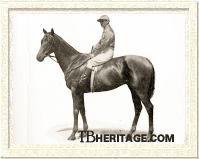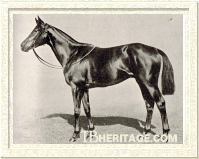|
|
Common

|
|
 |
|
|
Common was the first of two English Triple Crown winners sired by Isonomy. Despite his success on the turf, he had little impact after retiring to stud.
He was bred by Lord Alington out of Thistle, who was by the great broodmare sire, Scottish Chief. After Common, Thistle foaled the Ormonde colt Goldfinch, (winner of the New Stakes and sire of classic-winning filly Chelandry), and the Petrarch filly Throstle, winner of the St. Leger, Coronation Stakes and Nassau Stakes and dam of Missel Thrush. Common was, however, vastly superior to his two half siblings.
His sire, Isonomy, by Sterling, was a game, high-class stayer who won the Doncaster Cup and the Ascot Gold Cup twice, among other races, and later proved to be a top sire who got two good sire sons, Gallinule and Isinglass.
Common was raced by his breeder in partnership with Sir Frederick Johnstone, this duo having enjoyed Derby success previously with St. Blaise. Lanky and overgrown, he was sent to trainer John Porter's Kingsclere stables as a yearling, but Porter refrained from running him at age two, due to his immaturity.
Common made his racecourse debut in the Two Thousand Guineas, and won effortlessly by two lengths. For the Derby, Common was the favorite, even though his physical appearance was unprepossessing. Prince Saltykoff had once commented that Common was "very well named." But his looks did not hinder his Derby performance, for he won in a driving rainstorm by two lengths from the French colt Gouverneur (by Sterling son, Energy). Common next beat a solitary opponent in the St. James's Palace Stakes, then ran third to Surefoot and Gouverneur in the Eclipse Stakes. Common closed out his career with a length victory in the St. Leger.
Common was sought after as a stallion prospect by the Austrian government, and they offered Lord Alington and Sir Frederick Johnstone 14,000 guineas. The offer was refused, but two days later, he was sold to Sir Blundell Maple for 15,000 guineas. The Austrians offered Sir Blundell 20,000 guineas, but he decided to keep his purchase. At the price he paid, there was no question of continuing Common's career on the turf, even though he was sound and fit. Blundell sent Common to stand at his Childwick Bury Stud for a fee of 200 guineas. Porter later stated he believed that had Common remained in training he "...would have proved one of the greatest Cup horses of modern times."
|

Osbech

Mushroom | | Common sired one classic winner, the One Thousand Guineas victress NUN NICER (1895, from Priestess by Hermit). Another daughter, FAIRMILE (1895, out of Lady Clarendon, by Hampton), won the Yorkshire Oaks, and his filly COMMUNE (1902, out of Jersey, by St. Simon) won Ascot's Coronation Stakes.
His best son was OSBECH (1895, from Alibech by Hermit), a good stayer whose wins included the Liverpool Spring Cup (1900), Doncaster's Great Yorkshire Handicap (1900), the 2-1/2 mile Jockey Club Cup (1900) and the two-mile Northumberland Plate (1902). His other good runners were SIMONY, winner of the Union Jack Stakes; COTTAGER (1898, out of Marguerite by Trapeze), who took Hurst Park's Victoria Cup; and MUSHROOM (1911, out of Quick, by Cherry Tree; in-bred to Sterling), winner of the Fern Hill Stakes, the City and Suburban Handicap, and the Midsummer Stakes, in which he beat Prince Palatine. Mushroom was later a successful stallion in Belgium. |
After Sir Blundell's death in 1904, Common was sold, with his fee over the years reduced to 19 guineas. He died on December 17, 1912 at the Chelmsford stud of Mrs. Boyce Burrow.
--Liz Martiniak |
|
|
|

